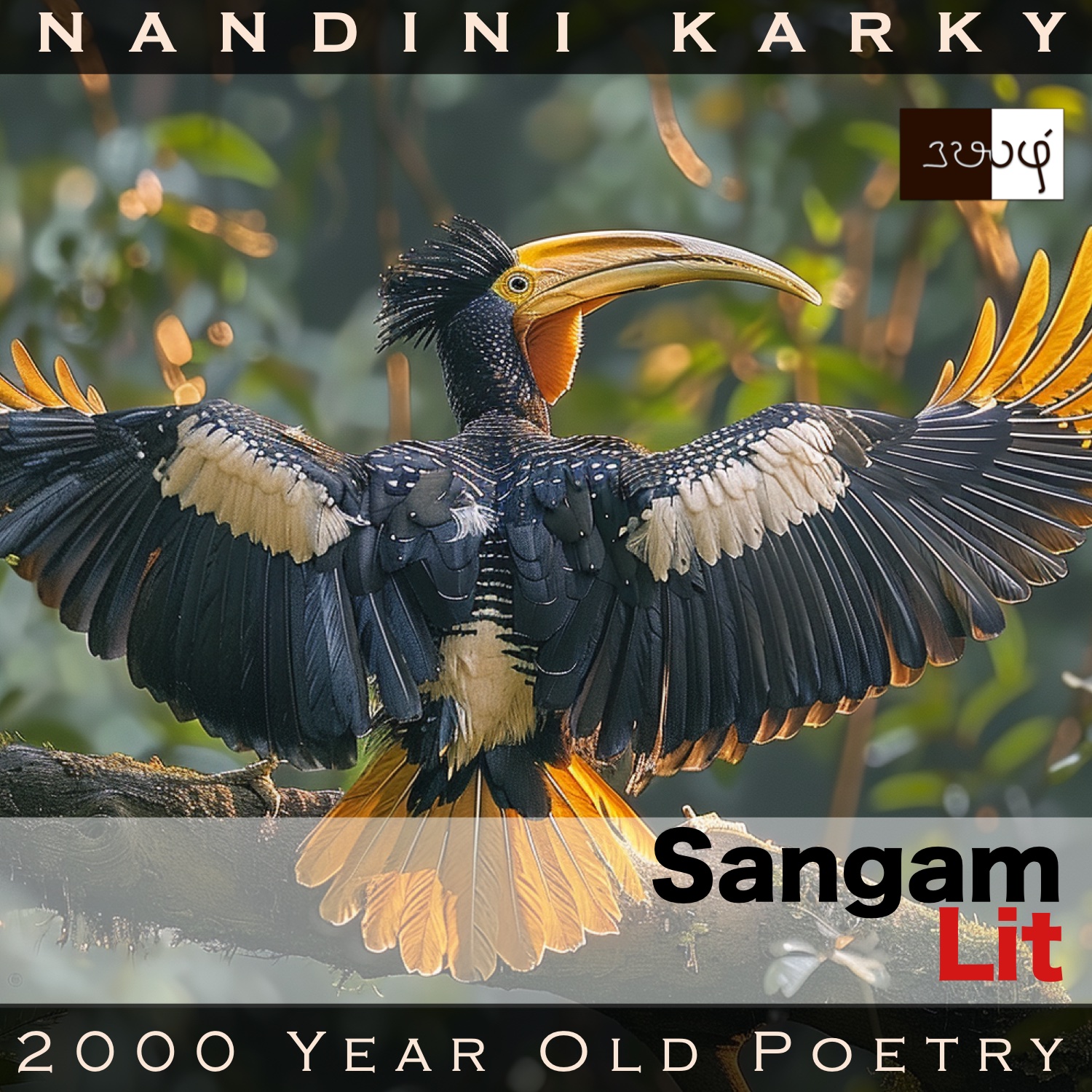Podcast: Play in new window | Download
Subscribe: Apple Podcasts | Spotify | Amazon Music | Android | iHeartRadio | TuneIn | RSS | More
In this episode, we perceive striking similes and subtle metaphors, as portrayed in Sangam Literary work, Puranaanooru 342, penned by the poet Arisil Kizhaar. The verse is situated in the category of ‘Kaanji Thinai’ or ‘Defence’ and talks about the fierceness of a maiden’s family.

கானக் காக்கைக் கலிச் சிறகு ஏய்க்கும்
மயிலைக் கண்ணி பெருந் தோள் குறுமகள்,
ஏனோர் மகள்கொல் இவள்?’ என விதுப்புற்று,
என்னொடு வினவும் வென் வேல் நெடுந்தகை!
திரு நயத்தக்க பண்பின் இவள் நலனே
பொருநர்க்கு அல்லது, பிறர்க்கு ஆகாதே;
பைங் கால் கொக்கின் பகு வாய்ப் பிள்ளை
மென் சேற்று அடைகரை மேய்ந்து உண்டதற்பின்,
ஆரல் ஈன்ற ஐயவி முட்டை,
கூர் நல் இறவின் பிள்ளையொடு பெறூஉம்,
தண் பணைக் கிழவன் இவள் தந்தையும்; வேந்தரும்
பெறாஅமையின் பேர் அமர் செய்தலின்,
கழி பிணம் பிறங்கு போர்பு அழி களிறு எருதா,
வாள் தக வைகலும் உழக்கும்
மாட்சியவர், இவள் தன்னைமாரே.
Refreshing to see a verse with all the words intact. The previous fragmented verses show us what a privilege it is to have recovered these verses from the claws of time. This verse continues in the same theme of seeking a royal maiden’s hand. The poet’s words can be translated as follows:
“Akin to the spreading wings of a jungle bird are the jasmine-garland-clad, huge arms of the young maiden. You ask me anxiously whose daughter she is, O great leader with a victorious spear! Her beauty is of a divine and desirable nature and can be attained only by a man from a warrior clan and not by anyone else. The young one of a green-legged stork, with an open mouth, after grazing through the soft sands of the shore and feeding thither, then gets the eggs of eels, akin to mustard seeds, and sharp, fine shrimps and shrimp-lets. Such is the cool and moist farmland town ruled by this girl’s father. As great kings, unable to attain her, waged war on her father, her esteemed brothers flashed their swords and threshed the battlefield every day, wielding their elephants as oxen upon those heaps of corpses many!”
Time to delve into the nuances. The poet begins in a dashing style with a simile talking about how the thick arms of the maiden adorned with jasmine garlands look like the spread-out wings of a forest bird. The Tamil term he uses is ‘Kaana Kaakkai’ and though the word ‘Kaakkai’ refers to ‘a crow’ in contemporary times, it’s not a jungle crow that this poet is referring to, but a ‘Great hornbill’, a stunning bird found in the Western Ghats although in deteriorating numbers today. If you pause for a moment and look up a picture of a ‘Great hornbill’ with its wings opened out in full glory, you will see the aptness of this poet’s comparison. He sees the black and white pattern on the Hornbill’s wings in the white strands of jasmine adorning the black shoulders of this Sangam maiden.
Returning from this awe-inspiring connection, we see the poet now repeating a question that a young man asked him about this very girl, wondering whose daughter she was. It should be noted that the poet addresses the man asking the question as a respected leader who holds a spear of victory. Then, he goes on to say that the maiden’s splendid beauty can only be claimed by someone from a warrior clan and not by anyone else. Then, the poet seems to journey elsewhere for he starts talking about a stork’s young one, grazing intently on the shores and finding fish thither. Even after having that satisfying meal, it keeps getting more from its mother bird in the form of eel eggs, shrimps and shrimp-lets. The poet seemingly talks about this scene only to describe the fertile lands ruled by that maiden’s father. However, we can infer that the content life of that stork chick reveals the protected and pampered state of this lady in question.
From the abstractions of these metaphorical references, the poet turns to the reality of the situation and talks about how many great kings had come to claim the maiden and when they were refused, they had waged war on the girl’s father. However, the girl’s family was not to be cowed down by these violent attacks. In response, the lady’s brothers, with such a strong and ferocious nature, had subdued the attack with their swords, and then day after day, they had threshed those heaps of corpses, akin to stacks of hay, with their battle elephants, akin to the threshing oxen, the poet concludes with a series of similes.
And yet again, we find the father and brothers refusing the hand of the girl from their family to suitors who come claiming her. Reverting back to the image of the spread-out wings of the hornbill in the beginning of the verse, although such a picture of freedom and flight is evoked, it’s clear that’s not the reality of the girl’s situation, for she has nowhere to fly to, as she is held within her golden cage by her family. This makes us wonder, what do the family look for in the groom? What nature or quality will satisfy them as being worthy to win their beloved girl? Let’s keep looking for answers to these questions and meanwhile, appreciate the creativity of these Sangam poets in conjuring up these picturesque parallels from the natural world!




Share your thoughts...